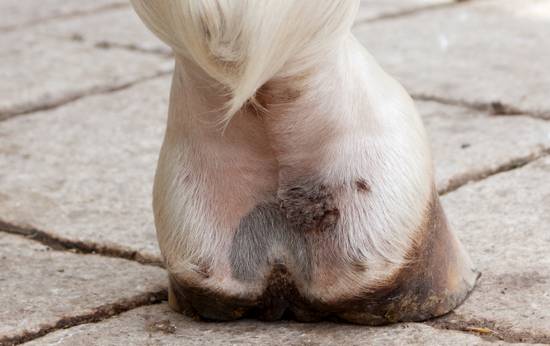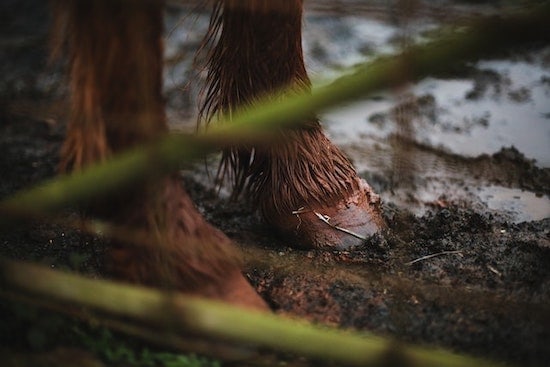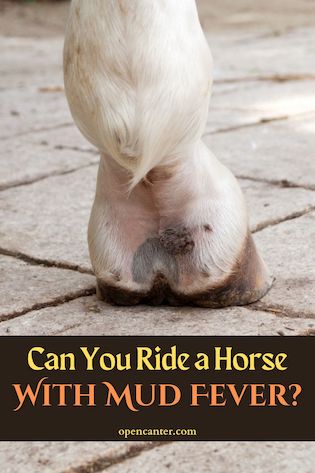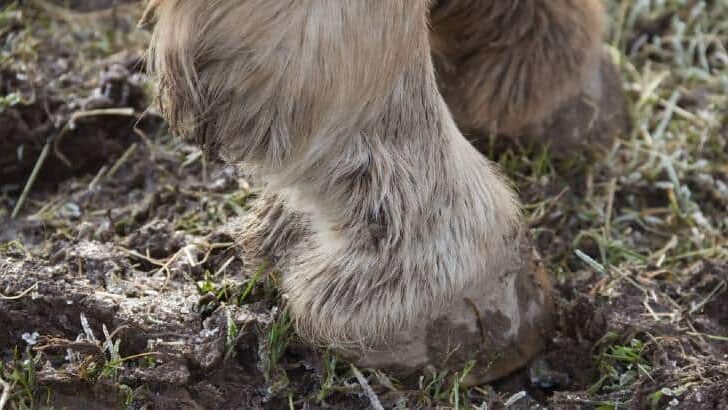Affiliate Disclaimer
As an Amazon Associate I earn from qualifying purchases. It helps me keep the website going. Thank you for your support.
If your horse has mud fever, you will have some questions about your horse’s welfare. But equally, you will most probably be wondering about how it impacts their exercise regime and your riding. The question is, can you ride a horse with mud fever?
Whether you can ride a horse with mud fever depends on how severe it is. In mild cases where there’s only a slight reddening to the skin, light work is still possible. Keep to dry ground and avoid the horse sweating. If you ride a horse with mud fever when the skin is cracked, however, you risk delaying healing.
Let’s take a closer look below at exactly what mud fever is, how to treat it effectively, and how to stop your horse from getting it.

What is Mud Fever?
Firstly, mud fever isn’t just one disease. It’s a collective term for a group of symptoms with several different causes. Other common names are dew poisoning, greasy heel (due to its wet look), and Pastern Dermatitis. As the last name suggests, the condition is usually seen around the heel area and up to the fetlock. When this disease is seen on the back and flanks, it’s called Rain Scald.
Symptoms of Mud Fever in Horses
- Red heels (strawberry foot) due to inflammation.
- Matted crusty hair, followed by hair loss.
- Scabs/lesions.
- Green/yellow discharge.
- Cracked skin.
- Painful to the touch.
- Swelling – this can happen with or without lameness.
- Lameness or resting the affected leg.
The first sign of this problem is when the skin at the back of the pastern or heel, is red and inflamed looking. The skin also becomes thickened and can progress up the leg as far as the fetlock. In severe cases left untreated, it can also spread up the cannon bone to the hock.
Once a discharge starts the hair becomes crusty, and there’s accompanying hair loss. As the infection grows, this becomes more severe within any skin folds. The leg often takes on a wet appearance from the clear exudate, turning to green/yellow as the infection develops.
Thick crusts that hold the bacteria then develop, and the horse can become lame at this point. Severe cases will be very painful, hot to the touch, and more difficult to treat. Even when diagnosed early, it’s always important to continue to monitor the affected area closely.
Causes
- Dermatophilosis Congolensis (this is the same bacteria present in rain rot) or Staphylococcus.
- Insect bites.
- Fungal infection (Dermatophytes), eg. Ringworm. Moist conditions can function as a reservoir for these organisms too.
- Mites – these can cause severe itching that results in skin abrasions. Also known as Mange.
- Mud build-up – only the top layer of mud dries out.
- Injury or wounds.
- Frequent leg washing and drying of the skin too vigorously.
- Standing in wet conditions for prolonged periods of time (rain or wet bedding).
- Sunburn in the summer.
- Weak immune system eg. PPID.
- Liver disease.
Can be more common in white-socked breeds, as the skin is more sensitive. As well as already living on a horse, bacteria and fungal organisms are also present in the soil. Consequently, your horse is at double the risk of infection once the skin has been broken.

Treatment
Treating a horse with mud fever can be a lengthy process, mainly because the area infected is always subject to some movement. In the first instance, it’s recommended to wash the affected area twice daily with a dilute antibacterial solution.
Don’t be tempted to remove the scabs, as this can damage the fragile skin underneath further and be very painful. They will gradually soften and come away as you wash down the area.
Whilst general advice is not to clip feathers, you may need to gently trim the affected area. This is especially if repeat applications are needed in order to apply creams/lotions effectively.
Also, change bedding more frequently to ensure a dry area, especially if you put your horse on box rest.
If there are no signs of improvement, consult your vet. They may need to take a skin sample to confirm the diagnosis and prescribe antibiotics or anti-fungal ointment as necessary. In very severe instances, a blood sample may be needed to identify an underlying systemic cause.
More Specific Treatments may be advised by your vet:
- Parasite treatment for mites eg. Fipronil is applied to the skin.
- Antifungal shampoos such as Miconazole.
- Steroid creams, injections, or tablets decrease inflammation.
- Antibiotics – oral/injectable.
- Application of sun-creams.
Complications
- Cellulitis – inflammation of connective tissue. Can be life-threatening if left untreated, as may spread to bone and muscle.
- Lymphangitis – inflammation of the lymphatic system, also potentially life-threatening.

How Can We Prevent Mud Fever in Horses?
- Keep your horse away from wet, muddy areas if possible. Consider putting hardcore down in gateways or areas where your horse often stands. If this isn’t possible, keep your horse in during long spells of wet weather.
- If stabled, leave your horse’s legs to dry naturally overnight, then brush any mud off in the morning. If you need to wash the legs, make sure you dry thoroughly by patting and not rubbing the skin.
- If your horse is affected, don’t share grooming equipment as this will spread bacteria.
- Don’t hose your horse’s legs down in cold weather.
- If your horse has feathers, the advice is not to clip, as the hairs provide a natural funnel for the water. If your horse doesn’t have feathers, make sure you pat the area dry carefully to avoid breaking the skin.
- Consider applying a mud barrier cream before turnout, especially if your paddocks are very wet. Avoid creams containing Paraffin as these will retain moisture.
- Boots can be useful if they are well-fitted and don’t rub.
For treatment to be effective and prevent further recurrence of mud fever, keep the skin clean and dry at all times. The disease can quickly recur if steps aren’t taken to manage paddocks and turnout appropriately.
Final Thoughts
Whilst you can ride a horse with mud fever, movement will often delay healing. It’s also key to remember that movement may be painful for your horse.
Spotting the disease early and treating promptly, will mean less time out of the saddle overall. Good management of turnout will reduce the risk of recurrence, however, keeping your horse out of the wet and mud is certainly a real challenge in soggy countries like the UK!




